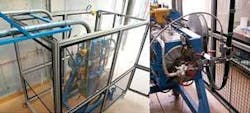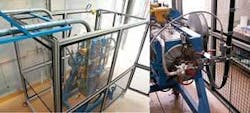Joint industry project to assess durability of cement formulations
Over the next few decades, the production of oilfields with high contents of associated sour gases will increase. Institut Français du Pétrole (IFP) estimates that 40% of the world’s remaining gas reserves contain more than 2% of CO2 and/or more than 100 ppm of H2S. Therefore, investigations on technologies to produce such fields are of utmost importance.
The major goal of the primary cementing operation is to provide complete and permanent zonal isolation of the well. This means the cement sheath must prevent fluid circulation (gas, oil, brine...) between different rock layers. To achieve this, many events must be addressed from the start of the cementing job through to plugging of the well.
Figure 1 shows the steps that need to be successful during the life span of the well. Durability concerns both production and well abandonment periods. The major differences between these two periods of well life are as follows:
- Mechanical loading: Stress variations within the cement sheath during production can be induced by thermal or/and pressure changes in the well. After plugging the well, a mechanical loading still can exist, but contrary to what happens during the production time, the stress changes occur more slowly and last over a very long time
- Downhole environment: Downhole pressure and temperature, as well as the nature of the fluids in contact with the cementitious sheath, vary generally over time and according to the well locations. For instance, field developments in areas of high sour gas content may require acid gas re-injection within the reservoir. In this case, the nature of chemical species varies with time, but also with the type of wells (producers, water injectors, or gas injectors).
Due to the presence of corrosive gas, special attention has to be paid to the design of well materials (casing, cementing materials). Corrosion of steel induced by acid gas-containing brines is well documented, while data on degradation by wet CO2 or wet H2S is more limited. For cementitious materials, there is abundant literature dealing with deterioration of cement pastes caused by a CO2 environment. Published data on degradation mechanisms of cement-based materials exposed to H2S environments are more scarce.
To correctly assess oil well cement durability, ageing tests must be carried out with fluids which represent the different life periods of the different types of well. For wells drilled in areas with high contents of H2S or mixed H2S/CO2, we can consider the following situations as critical from a chemical point of view:
- Primary cementing across the cap rock and the reservoir during the production
- Primary cementing during acid gas injection (in case of re-injection)
- Primary cementing and plugs after the end of the production and re-injection operations.
IFP has developed a methodology implemented under HP/HT conditions for aging tests of materials in H2S-containing fluids, in contact or not with casing materials, with a large range of characterization tests. Aging tests are being conducted in fluids representative of different periods of time at IFP’s facilities in Solaize. A test center there has been designed specifically for an H2S safety environment (Fig. 2). A sampling line has been put on the pressurized cell to allow analysis of the aging fluid as a function of time; it is helpful to get a material balance and a better analysis of the chemical reactions that occur.
Tests use agitated cells configured at temperatures and pressures from 150° C, 1,000 bar up to 250° C, 275 bar, so that gas/liquid contact is maintained during the aging process. Similar aging tests are performed in lime-saturated water for comparison. More than 200 plug samples generally are tested for specific fluid composition. For each sampling, different macro-scale measurements are performed: evolution of sample weight, evolution of sample volume, variation of compressive strength, variation of flexural strength, and water permeability.
A structural characterization also involves:
- X-ray tomography in a first attempt to control the density variations. This is non-destructive, allowing investigation of the material’s internal structure, in turn facilitating location of the degradation front in the material
- Porosity and pore size distribution via mercury intrusion porosimetry on the cement paste
- Mineralogy of degraded cement paste by X-ray diffraction (XRD), thus permitting phase identification
- X-ray fluorescence to quantify the main element of the cement paste
- Observation of the matrix by electronic microscopy equipped with an energy-dispersive spectrometer microanalysis to characterize the local mass percentages of Ca, Al, Fe, Si, and S within the degraded matrix.
The Acacia JIP, led by IFP, and currently including Total, Eni, Schlumberger, and Petrobras (membership/sponsorship is still open) aims to characterize and understand the chemical degradation of different cement-based materials in contact with acid gas mixtures such as CO2 and H2S. For the materials exhibiting the best durability, the tightness of cement/casing interface and cement/formation interface will be measured.
Eric Lécolier, Yann Monnin, Alain Rivereau, Xavier Longaygue, Joseph Martin, Annie Audibert-Hayet - Institut Français du Pétrole

